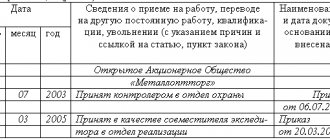How to draw up an employment contract
The procedure for concluding a rental agreement involves the following stages:
- Oral stipulation of requirements and mutual conditions. After agreement is reached, the practical stage of drawing up the contract begins.
- Preparation of documentation by the candidate. They are transferred to the production personnel department. The employer gets acquainted with the documents and decides whether the applicant is suitable for performing a particular type of work.
- Familiarity with the rules and conditions of work under the agreement. The applicant signs the document on job responsibilities, thereby confirming his readiness to work in accordance with the assigned daily routine and to complete the assigned tasks in full.
- Drawing up a rental agreement. There is no single regulated sample of this document.
- Signing the contract. The law requires that, in addition to the signatures of the parties, there must be a handwritten resolution of the future employee.
- Beginning of work. The agreement comes into force from the moment it is signed. The employer additionally issues an order to hire a new employee.
ATTENTION! The agreement is drawn up in two copies. One original document is given to the new employee.
The candidate provides the following package of documents:
- passport;
- document confirming education;
- military ID (for men);
- SNILS;
- TIN;
- compulsory health insurance policy;
- employment history.
ATTENTION! If an employee gets a part-time job at an enterprise, he provides a copy of the work book approved by the administration of another place of work.
Types of employment contract
According to Russian legislation, employment contracts are officially classified depending on their duration and are:
- fixed-term contracts (concluded for a certain period, but not more than 5 years);
- contracts that are concluded for an indefinite period.
In turn, fixed-term employment contracts provide for several types of contractual agreements, which are based on the reasons for termination of their validity:
- Employment contracts with an absolutely definite term (for example, election to an elective position with a fixed term).
- Employment contracts with a relatively specific period (usually concluded between an employee and the head of an organization created to perform certain functions).
- Employment contracts are conditionally fixed-term (concluded with employees temporarily replacing an absent person).
A fixed-term employment contract is concluded in cases of temporary or seasonal work (Part 1 of Article 59 of the Labor Code of the Russian Federation), that is, when the labor relationship is determined by the nature of the work and the conditions of its implementation. Also, Part 2 of Article 59 of the Labor Code of the Russian Federation provides for cases when a fixed-term employment contract can be concluded exclusively by agreement of all involved parties. Accordingly, an employer’s refusal to hire a person wishing to sign an employment contract for an indefinite period will be considered unlawful, except in cases where the refusal is based on the lack of professional and business qualities of the potential employee.
An employment contract is considered concluded for an indefinite period if its clauses do not contain information about the duration of this employment agreement. The absence of a demand from one of the parties to terminate a fixed-term employment contract due to the expiration of its validity period indicates that the condition on the fixed-term nature of the contract loses force and employment agreements arise for an indefinite period.
Types of employment contracts also include civil service contracts, however, it is worth noting that such labor agreements are regulated by special laws regulating certain types of civil services. Labor legislation does not contain labor law provisions regarding persons:
- military personnel in the performance of military service duties;
- working on the basis of contracts of a civil nature;
- members of boards of directors (supervisory boards) of organizations (except for persons who have entered into an employment contract with this organization).
In addition to the main types of employment contracts, there are a number of other criteria on the basis of which an employment agreement is concluded:
- by type of employer (with legal entities or individuals);
- according to the specifics of the employee’s legal status (with minors, with foreign citizens and stateless persons);
- by the nature of the conditions (work in normal conditions, at night, harmful/dangerous conditions, work in special climatic zones, etc.).
Form and types of employment contract
Requirements for the contract form:
- numbering and binding of all pages;
- signatures of participants on each sheet;
- Empty columns are not allowed.
Types of contracts and features of their content are presented in the table:
| Criteria for distribution by type | Name | Features of compilation |
| Validity | · unlimited; · contract with a limited duration; | · the law establishes that all contracts must be indefinite, and the limitation of the duration of the agreement can only be determined by the specifics of job responsibilities (seasonal work, one-time performance of a specific amount of work, military service); · a fixed-term agreement lasts no more than five years; |
| Type of employment | main place of work; · part-time job; · public service; · home-based employees; | · establishment of a specific work schedule and duration of the working day; |
| Working conditions | · harmful production; · overtime hours; · night time; · Far North; · normal conditions; | · wages must be calculated in accordance with the severity and danger of the work performed; Availability of additional compensation; |
| Categories of employed persons | · Foreign citizens; · minors; · disabled people; · parents who have dependent children under three years of age or children with disabilities. | · the specifics of concluding an employment contract affect working conditions, the length of the working week and the rules for assigning leave. |
Rules for drawing up an employment contract with an employee
For the document to be valid, it is necessary to indicate in it:
- time and place of compilation
- organization data, employee data
- the nature of the obligations, working conditions, the contract should include all important characteristics of the position, location of the workplace
- calculation rules, when wages, bonuses are paid, in what order (cash or non-cash payment)
There are some simple rules on how to draw up a tenancy agreement. It is necessary to carefully study the regulations and comply with them; failure to conclude an employment contract leads to liability and fines. Many companies believe that in the contract they can establish any rules, obligations, penalties, and so on. However, the law will be more important than the contract in the event of litigation. When considering the question of how to correctly draw up an employment contract, it is also necessary to take into account exactly how the employee will be hired. If this is a part-time activity, different rules apply, as in the case of a fixed-term cooperation agreement.
It will be possible to make changes to the agreement in the future by concluding additional agreements signed by each party.
ATTENTION : watch the video on the topic of protecting the labor rights of an employee, and also subscribe to our YouTube channel to be able to receive free online legal advice through comments on the video.
List of mandatory terms of the contract
The Labor Code requires that the contract contain the following information:
- personal information about the employee;
- grounds for concluding an agreement between the participants;
- type of contract (indefinite, fixed-term or for seasonal employment);
- the terms for the agreement to enter into legal force;
- type of employment (full-time, part-time or part-time);
- the period from which the candidate must begin work;
- the duration of the probationary period, the amount of wages during this time;
- job responsibilities of the candidate;
- employer responsibilities;
- rights of participants;
- working conditions and daily routine;
- payment terms and wages;
- a list of payments that make up the salary;
- conditions for receiving leave;
- terms of contract termination;
- date of conclusion and signature.
A sample agreement at each enterprise is drawn up in accordance with the characteristics of production.
Responsibility of the manager for refusal to draw up a written contract
As stated above, refusal to conclude an appropriate written agreement with hired personnel is illegal. The violator is brought to administrative responsibility.
The penalty in this case is the imposition of a fine in the amount of:
- from 10 thousand to 20 thousand rubles – for officials;
- from 50 thousand to 100 thousand rubles – for companies;
- from 5 thousand to 10 thousand rubles – for private entrepreneurs.
CONCEPT, PARTIES, CONTENT, TYPES OF EMPLOYMENT CONTRACT
In the vast majority of cases, labor relations arise on the basis of a special legal fact - an employment contract.
An employment contract is an agreement between an employee and the owner of an enterprise, institution, or organization. In accordance with it, the employee undertakes to perform certain work subject to internal labor regulations, and the owner undertakes to pay the employee wages and provide the necessary working conditions.
Parties (participants) of the employment contract:
1) employee. In order to conclude an employment contract, a person must have legal capacity to work and legal capacity (legal personality).
Labor legal personality differs in nature from civil legal personality. It has different age limits: it occurs after reaching the age of 16 years. In exceptional cases, with the consent of one of the parents (adoptive parents) or guardian, it is allowed to employ a person who has reached 15 years of age. It is possible to employ students in their free time from school when they reach 14 years of age with the consent of one of the parents (adoptive parents) or guardian. It is important that the work performed by such an employee is easy, does not cause harm to health and does not disrupt the learning process.
Persons recognized as civilly incompetent due to mental illness or dementia may have legal personality at work;
2) employer. The person providing the work may be the owner of the means of production - a legal entity (enterprise, institution, organization) or a body authorized by the owner. The legal personality of a legal entity arises at the time of state registration. An employer can also be an individual - for example, an entrepreneur who carries out business activities without forming a legal entity, a person who hires a domestic worker or governess.
The content of the employment contract consists of the conditions on which an agreement is reached between the employee and the employer. Conditions are divided into two groups:
1) necessary (mandatory) conditions, without which an employment contract is impossible. These are: place of work, labor function (i.e., specific work that the employee will perform), start date of work, wages;
2) additional (optional) conditions. This group of conditions becomes mandatory only when they are included in the employment contract. In other words, an employment contract can be concluded without additional conditions. These include, for example, a probationary period when hiring, part-time work, benefits and social security services, etc.
The terms of the employment contract should not worsen the employee’s position in comparison with the law. Otherwise, such an agreement is considered invalid.
Types of employment contracts are distinguished depending on the period of conclusion. An employment contract can be concluded for:
1) indefinite period (unlimited contract);
2) a certain period;
3) for the duration of certain work.
An employment contract in which the employer is an individual must be registered with the state employment service.






